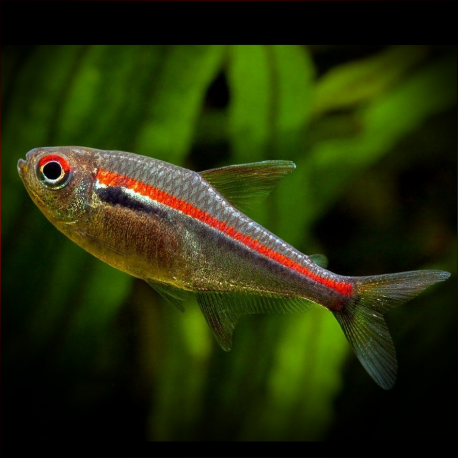More info
Datasheet
| Minimum Tank Size | 60 litres / 15.85 US gallons |
| Maximum Size | 3.0cm / 1.18inches |
| Temperature | 23°C / 73.40°F - 28°C / 82.40°F |
| Hardness | 1.01dgH / 18ppm - 8.01dgH / 143ppm |
| pH | 5.0-7.0 |
General Description
The Amapá Tetra, scientifically known as Hyphessobrycon Amapaensis, is a species of fish sometimes referred to as the "red line," "scarlet," or "neon black red stripe" tetra. It closely resembles the flag tetra, H. heterorhabdus, but can be differentiated by its broad red stripe, creamy-colored central stripe, and horizontally-orientated humeral spot. Belonging to the Characidae family, this tetra is part of the Hyphessobrycon genus and is native to small streams in the rio Preto and rio Maraca drainages of Amapá state in northeastern Brazil.
Aquarium Setup
For the optimal care of Amapá Tetras, a tank of at least 60 liters is recommended, given their peaceful nature. They thrive in a community aquarium environment alongside similarly-sized fish like characids, gasteropelecids, and small-to-medium-sized cichlids. It is advised to keep a mixed-sex group of 8-10 specimens with schooling fish to provide security and create a natural-looking spectacle. The tank setup should include a sandy substrate, driftwood roots, branches, and dried leaf litter for a more natural feel.
Behaviour
Amapá Tetras are known for their peaceful temperament, making them ideal residents in a well-researched community aquarium. They exhibit schooling behavior and should be kept in groups to encourage natural behavior and reduce stress. These tetras are active swimmers and feel most secure when kept with other schooling fish species.
Feeding and Diet
Being omnivorous, Amapá Tetras feed on small invertebrates, crustaceans, filamentous algae, and fallen fruit in their natural habitat. In captivity, they can survive on a diet of dried foods but thrive when offered a varied menu including live and frozen foods like chironomid larvae, bloodworms, mosquito larvae, Daphnia, and Moina. A balanced diet promotes the health and vibrancy of these fish.
Reproduction & Dimorphism
Amapá Tetras are egg-scattering free spawners that exhibit no parental care. To maximize breeding success, a separate breeding aquarium with dim lighting, a meshed substrate for egg protection, and slightly acidic to neutral water conditions is recommended. Sexually mature females are deeper-bodied and slightly larger than males, making sexual dimorphism noticeable in this species.
Habitat and Distribution
These tetras are found exclusively in the rio Preto and rio Maraca drainages within Amapá state, northeastern Brazil. They inhabit small streams with clear, light brown-colored water, sandy and gravel substrates, and minimal submerged vegetation. The pH in their habitat ranges between 5.8-6.3, with very soft water conditions and temperatures around 24.7-27.2°C (76.6-80.1°F).

